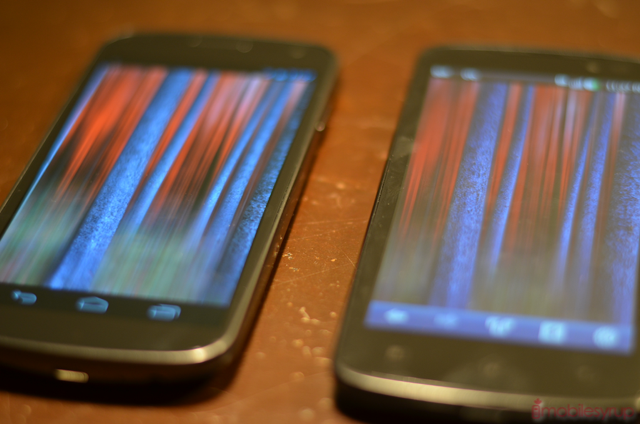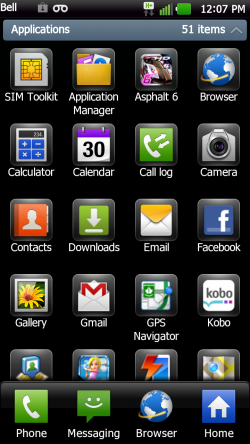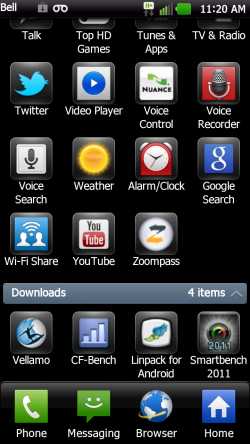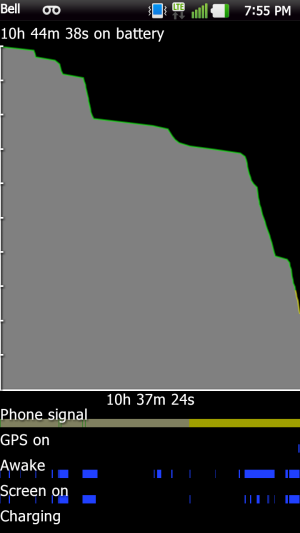
There is something wonderful about a company breaking new ground. Of the myriad Android reviews over the past few weeks, the LG Optimus LTE is probably the biggest wildcard. On paper the phone has everything: a dual-core processor, HD screen, LTE connectivity. In fact it’s the only device outside the US to have both a 720p screen and LTE support. There is intense competition for the high-end Android space right now, and LG is coming in hot, guns blazing.
With the Galaxy Nexus nipping at its heels, can the Optimus LTE deliver? And where does it fit in Bell’s lineup of superphones? Read on to find out.
Specs:
– Android 2.3.5 (upgradeable to 4.0 upon release)
– 1280×720 TrueHD IPS display
– 1.5Ghz dual-core Snapdragon processor
– 1GB RAM, 2GB internal storage, 8GB microSD card included
– 8MP camera with flash / 1.3MP front camera
– 1080p video capture
– WiFi (b/g/n), Bluetooth 3.0 w/ A2DP, A-GPS, WiFi Direct, MHL(HDMI) out, DLNA support
– LTE 75Mbps 700/1700Mhz, HSPA/UMTS 21Mbps 850/1900/2100 MHz
– 133.9 x 67.9 x 10.48 mm, 135g
– 1830mAh battery

The Phone
The Optimus LTE gives a very good first impression. It straddles the border between comfortable and bulky, but manages to slip into the former. At 10.5mm thick and 135g it fits right in with the latest Galaxy S II devices though it is slightly thicker. That thickness gives the impression of sturdiness, something this symmetrical monolith can boast assuredly. In the hand, despite its plastic construction, there isn’t a creak or seam; the body is crafted from premium polycarbonate plastic, and the battery cover a nice machine-cut overlay that wraps around the side of the phone. The left side volume rocker is nicely delineated with plenty of travel. The top portion of the device is the busiest, with a headphone jack, a microphone, microUSB/MHL port under a plastic door, and a power button on the right side.

It seems that all the devices we’ve reviewed recently, from the Motorola Razr to the Galaxy S II LTE, have a small chin at either the top or bottom, throwing off its symmetry and balance to some extent. Despite its relative thickness it’s nice to use a device again that feels uniform in the hand, regardless of how you hold it. The textured backing has a diagonal pattern that is conducive for gripping in even the sweatiest hands; the grooves are wide and attractive.
Along with the power button, the only metal present on the device is on a little vertical stripe housing the camera optics. Like the Optimus 2X, LG has opted for small flourishes that save money but ultimately delight their customers. Underneath is a 1830mAh battery, an 8GB microSD card and a SIM card slot.
Around the front LG has wisely consolidated the menu and search buttons into one superbutton, allowing for large spaces between it, the home and back buttons. In order to activate the search portion, just hold down the button for a second.
Overall the Optimus LTE isn’t a striking or beautiful device, nor is it plain and utilitarian. There is a pleasant symmetry to its curved top and bottom, an austere and familiar consistently with previous LG devices and, most importantly, a nice balance between form and function.

The Display
Of course this needs its own section. The Optimus LTE is the second device we’ve used with a 720p display after the Galaxy Nexus, but in many ways the True HD here is a different beast altogether. LG has wisely spent the extra money on an IPS panel, so viewing angles are practically endless. Colours are accurate and clean: no Super AMOLED oversaturation here. Text is dead-sharp, arguably more so than the Galaxy Nexus, with bright, accurate white levels. Blacks, and by virtue contrast, vary with brightness but for the most part fare quite well. Coming from the perfect black levels of the Galaxy Nexus it’s nice to know that the Optimus LTE holds its own in that regard, though obviously contrast is not quite up to par. The backlight is very strong, and we’re happy to report that Optimus LTE didn’t have any of the light bleeding issues that plagued the Optimus 2X.
Our one concern is that there is a fair amount of dithering on colour gradients, interrupting the generally-smooth flow of images and icons. While it’s not immediately noticeable and depends highly on the quality of the image’s texture, it is present throughout the OS. One of the most egregious examples of this are the jagged line transitions present on the first screen of the Marketplace (see photo).
One boon for the IPS display is that it is bright enough to be seen in relatively direct sunlight. Though we haven’t seen a single backlit device that fares particularly well in the sun, LG had the presence of mind to beef up the maximum brightness on this display; at auto brightness it is even a bit too high. We wouldn’t complain except our battery life suffered as a result: we’d recommend manually setting the screen brightness to around 30%.
A lot of people are going to ask if the display is as good or better than that of the Galaxy Nexus. There are a couple reasons it is, and a couple it is not. Firstly, having perfect blacks on a display changes everything, including the colours that aren’t black: colours are punchier and more vivid. But with such great contrast comes a trade-off: whites, especially at lower brightness levels, have an icy blue tint to them. As you move up the gamut it becomes less pronounced, but because the Galaxy Nexus has a very sensitive auto-brightness mechanism, the majority of the white you see will have that bluish hue. The Optimus LTE suffers no such fate: whites are some of the cleanest, most accurate out there. Colours are great but for the dithering problems I mentioned, and maximum brightness is significantly higher. Both have comparable viewing angles.
Overall, both displays are tightly matched but I’ve give an edge to the Galaxy Nexus in terms of overall vividness, contrast and viewing angles.
Performance
LG is sticking with what works here, and like HTC and Samsung, have chosen the 1.5Ghz dual-core Snapdragon S3 SoC to power their mighty beast. It’s clear that LG has worked some voodoo magic here, since the LG flew through all its synthetic and real-world benchmarks, and never seemed to skip a beat in our browsing tests. Apps loaded quickly, 720p video streamed effortlessly and the whole experience shone.
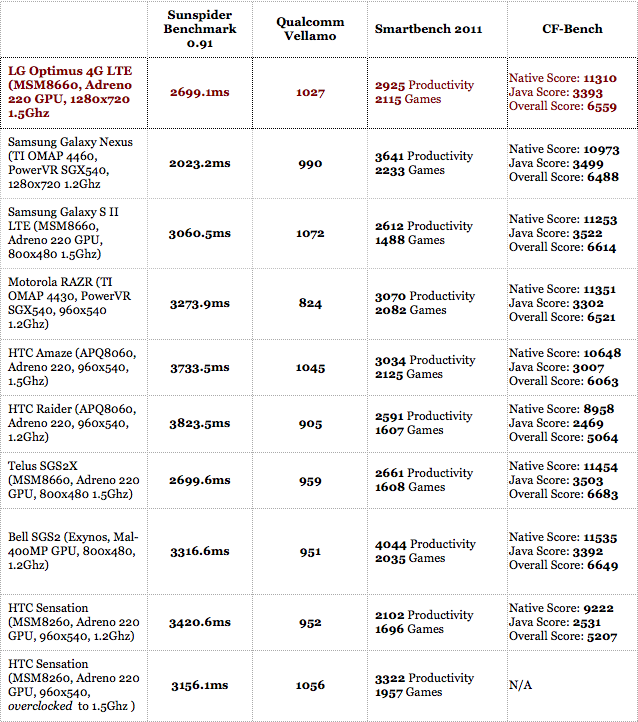
Despite the high native resolution the graphics chip kept up remarkably well: take a look at the benchmark results next to the Galaxy Nexus, which runs a slightly slower CPU but faster GPU. The LG kept up in most regards, with a few of the more graphics-intensive tests being taken by the pure Google device. We can also say with confidence that once the Optimus LTE gets Android 4.0 it will only get faster.
It’s very difficult to judge, however, which Android device is the smoothest these days. Android 2.3.5 does not have the same dual-core optimizations that debuted in Ice Cream Sandwich, so any hardware acceleration is implemented by the OEM. It’s clear LG has done some work to speed up the browser which matches the lower-resolution Samsung Galaxy S II blow-for-blow. But when you get to these speeds, it’s hard not to find fault in even the most minor stutter or delay. At times we found the keyboard to fall behind our flurry of presses, or the browser would stall for 10-15 seconds before resuming its page rendering. Before Ice Cream Sandwich we’d say, oh it’s typical for Android, but now we that know these issues have been largely resolved it’s hard taking a step backwards.
Software
The Optimus LTE follows the same path as the Optimus 2X, though it ships with a newer version of Android in 2.3.5. It arrays Gingerbread in colourful icons, garishly outlined in a sort of protective bubble we wish was absent. There are seven home screens, though they can be removed by pinching your fingers together and dragging one to the trash can. In fact, LG has affectionately borrowed much of Android’s customization from HTC and Samsung, though in truth every manufacturer shares a subset of features. What’s important is how well implemented those features are, and I can happily say LG hasn’t let us down.
There is a permanent four-icon dock at the bottom of the home screen, though the default icons can be moved around or removed. The app drawer, when opened, is pretty intuitive, dividing its wares into categories. Apps preloaded onto the device are stored in the Applications column; these cannot be removed or deleted, just relocated. Below that is the Downloaded category which stores all your Marketplace apps. Apps can be sorted by category, listed alphabetically or, more traditionally, scrolled through page by page.
LG bundles some of its well-worn Android offerings here, including the rather helpful RemoteCall which allows a representative from the company to remotely log in to your device to troubleshoot. Extensive DLNA supports comes by virtue of SmartShare, which streams your video, photos and music to any connected device.
LG’s SmartWorld is an Android app store. If you take the time to register an account, you are free to download certain “paid” apps for the low, low price of nothing. While most of the top apps are the same ones present in the Android Marketplace (really, Angry Birds?) there are a few interesting inclusions that should keep your app discovery pangs at bay. I just question the need for another proprietary app store, especially one with significantly fewer apps than the official one.
Taking a page from Samsung, LG has integrated gestures into the OS. Tilt your phone when moving an icon around the home screen and it uses your accelerometer to fly from side to side. Flip your device over to silence an incoming call or alarm, or to pause a movie clip. Though non-essential to one’s enjoyment of the phone, their inclusion is genuinely useful — if you can remember to use them.
One of the cooler features I wish more vendors would implement is WiFi Sharing. This allows two users connected to the same WiFi network to transfer image, video and music files from device to device without having to go through a central access point like a PC. The capabilities have been in the WiFi spec for years, it just took an enterprising mobile company to implement it. Not limited to just LG devices, most modern Samsung devices support WiFi Sharing, too.
Lastly, LG has licensed Nuance’s excellent voice recognition engine for its Voice Control app. I found it to be much more accurate than Samsung’s implementation of Vlingo — it actually knew who “Mom” was, someone the Galaxy S II insisted was called “Mark” — though it wasn’t possible to map it to a specific key like you can on the Samsung.
Oh, and screenshots can be taken by holding down the Home button and quickly pressing Power.
Connectivity
I’m just going to come out and say it: LTE is ridiculously, mind-blowingly fast. Bell and Rogers keep trading crowns as the speediest mobile carrier, and with the Optimus LTE tests it takes back the crown (though not by much). We were able to consistently get over 45Mbps download speeds and 15Mbps upload speeds. Think about that for a second. In the downstream that is equal or faster than many top-tier cable and fiber connections. In the upstream it is up to 15x faster than home broadband.
Not only do the results speak for themselves in speed tests, but they translate nicely into real-world performance. Over LTE, web pages load instantly. High-bandwidth sites that typically take minutes to render are complete in seconds. Think 500px.com; think Flickr. This is the first time in history that a device bottleneck is the CPU, not network speeds. Forget checkboards or spinning wheels, the only time you’ll be waiting for a page to load is when there is an excess of Javascript or Flash content.
Let me put it another way: I used this phone’s LTE connection to upload the YouTube video you see above. At 1.16GB it usually takes nearly 4 hours on my 1Mbps home connection. I completed the upload in less than fifteen minutes.
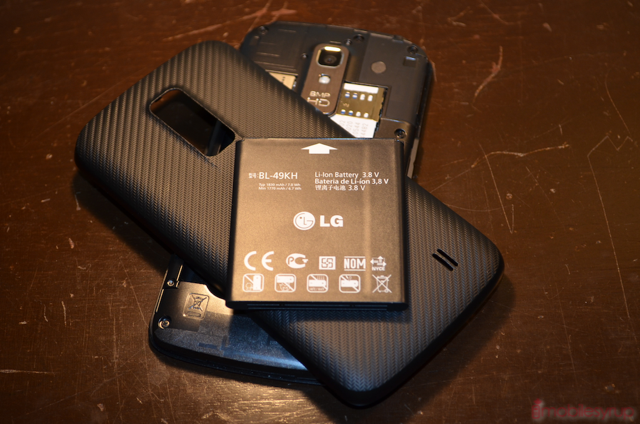
Battery Life
In truth, we expected battery life to be negatively affected by the high-resolution screen, powerful backlight and LTE chip. We just didn’t expect it to deplete this quickly. If you take a look at the screenshot of battery use, you’ll see that for most of the day the battery life decreased fairly slowly. This was because I was using the phone sparingly in an area with no LTE.
After coming downtown I began using the device as I would any other: downloading apps, surfing the web, streaming music and playing half an hour of games. Doing so took the battery from 70% to around 10% in less than two hours. In fact, LG claims only three hours of talk time on the device, even with its prodigious 1830mAh battery. Suffice it to say, if you’re going to be using the Optimus LTE to its fullest computational, graphical and connectable extent, I’d recommend investing in a second (or third) battery.
Luckily there is a toggle in the Mobile Network section of the Settings app to disable LTE. In that case the phone will fall back to Bell’s still-fast 21Mbps connection
Camera
We tried well-lit, low-lit, indoor-lit and sunny-lit, and only in the last scenario could we get a photo that wasn’t unreasonably blurry. Though possessed with fantastic macro abilities and a capable, fast autofocus lens, I was not happy with the majority of the results. While there were a few gems among the rough, with accurate colours and excellent dynamic range, images suffer from a softness that I couldn’t abide.
Individual settings such as white balance and exposure are editable, and there are various scenes to select from. None of these improve the quality of the camera sensor which continues the tradition of inferior photography offerings from LG . This is unfortunate and a mar again an otherwise fantastic product. In 2011, having a capable camera on a phone is bare minimum; having a bad camera is untenable. While it’s better than the average camera from a couple years ago — think iPhone 3GS plus a few million pixels — it can’t compete with the iPhone 4S’ and HTC Amaze’s of the world. That said it takes photos quickly, and when they turn out well they’re pretty nice to look at.
Luckily the front-facing camera isn’t as objectionable as the rear, owed to the fact that expectations are much lower. I am happy to report the 1.3MP camera is clear and capable, though there is plenty of noise in lower-light scenarios.
Video quality fares slightly better than stills: 1080p video, while soft, is smooth and artifact-free. For general use the quality is good enough to capture a kid’s birthday party or film your dog playing in the park, but if there’s anything important you need filmed I’d bring the point-and-shoot (or the iPhone 4S/HTC Amaze).
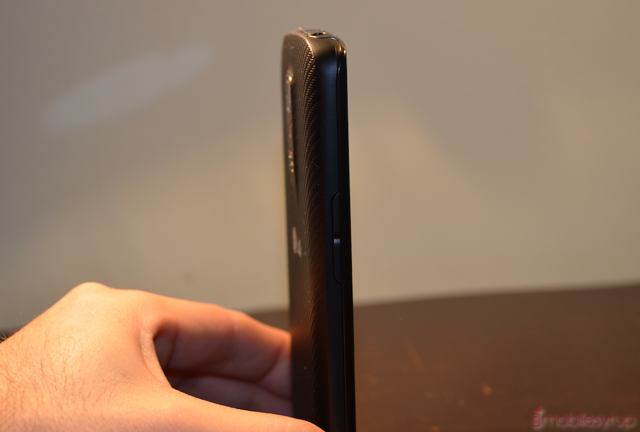
Sound Quality, Miscellany and Misgivings
There isn’t much else to say about the Optimus LTE, which comes in around the middle of the pack for sound quality and speaker volume. Making calls on Bell’s network resulted in clear, sharp dialogue and a distinct lack of background noise or hiss. The second microphone at the top adequately cancels ambient noise, though we were told our voices sounded rather tinny at times, like it was being wrung through a metal can. On our end, voices sounded normal and robust, so we’ll chalk it up to network conditions rather than a fault with the phone.
We tested our Bluetooth stereo headset with the Optimus LTE to great success; range was good and quality superb. Connecting our headphones also resulted in accurate, punchy music, though maximum volume levels seemed a tad low. The mono speaker on the back, on the other hand, produced excellent quality sound that was good enough to fill a whole room with a conference call. Recipients on the other end heard me loud and clear.
Bell bundles their standard suite of, ahem, bloatware, though as I’ve stated before there are a couple of great apps thrown in there. In particular their TV&Radio app shines, facilitating a wonderful mobile television experience for not all that much money. For those cord-cutters who still want a piece of the live TV action, this is definitely your best bet.
—
One note on LTE reception: due to the fact that Bell currently only uses the 1700Mhz frequency for LTE connectivity, reception will be less robust than a regular HSPA+ network which falls back to 850Mhz in times of multipath or signal fade. As a result, unless I was right downtown in the open air I rarely saw more than three bars of LTE. If I happened to fall back to HSPA+ I consistently had five bars. Keep that in mind if you live in a basement or in a place with thick concrete walls.
Another qualm we had with the device was its lack of internal storage. At 2GB is undercuts the industry by several times, opting instead to bundle an 8GB microSD card. The entire 2GB is given over to app storage, making it necessary to always have a card in the device. If you wish to upgrade to a larger size, you must be sure to copy the content over to the new one or risk losing essential app data.

Development and Upgrades
LG devices have always been pretty friendly to the developer community. The Optimus 2X received a CyanogenMOD 7 port fairly soon after it was rooted, and the community continues to thrive today. While I am not certain whether the bootloader is unlocked on the Optimus LTE there is no reason to believe the company would start now.
As for Ice Cream Sandwich, Bell’s own website states that it will be upgraded as soon as it is released. Without reading too much into that, we’re thinking they mean when LG releases it, not Google. Be that as it may, it’s a good sign when a carrier posts a message like that on their site before a device’s actual release. They know what people want, and people want ICS.
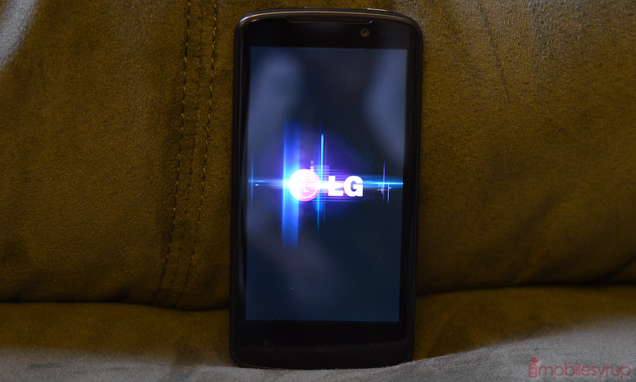
Final Thoughts
For all its virtues the Optimus LTE falls well short of greatness. For every high there is an equal low; for the wonderful screen there is a distracting dithering issue; for the ridiculous LTE speeds there is disappointing battery life; for the unparalleled performance, a poor camera.
I admit that I am a hardened critic trained and conditioned to see the worst in devices. In this sense I can forgive the screen issue as it will likely not be noticed by the vast majority of potential buyers. The camera and insipid battery life I’m not so sure about. LG had time to think whether they wanted to implement LTE in their flagship device, and it was a choice I’m sure they grappled with. Every manufacturer releasing a LTE device knows of the battery hit and not a single one decided to wait until the next generation, which will likely bring usage to parity with current HSPA+ solutions. And by bringing it to market they are banking on users understanding the shortcomings: with every first-generation technology there are sacrifices.
In other ways the Optimus LTE is the full package. It is fast, well-constructed with a beautiful screen and an OS as close to stock Gingerbread as you’re going to get. The 720p display and LTE connectivity are going to be more than enough to get people talking.
The LG Optimus 4G LTE is available from Bell for $149.95 on a 3-year term and $629.95 outright.
In addition, you can get this at Best Buy and Future Shop.
Rating: 7/10
Pros:
– Stunning 720p display has accurate colours, high brightness and endless viewing angles
– LTE speeds are the fastest we’ve ever seen
– Phone is blazing fast, beats most devices with the same chipset
– Nicely-constructed
– Comfortable to hold
– Subtle additions to OS like gestures are genuinely useful
– Nuance-powered Voice Control is accurate and fast
– Excellent reception and voice quality
Cons:
– Poor camera quality
– Dithering problems with screen
– LTE battery life drains fast
– No internal storage, only 2GB app storage
MobileSyrup may earn a commission from purchases made via our links, which helps fund the journalism we provide free on our website. These links do not influence our editorial content. Support us here.


